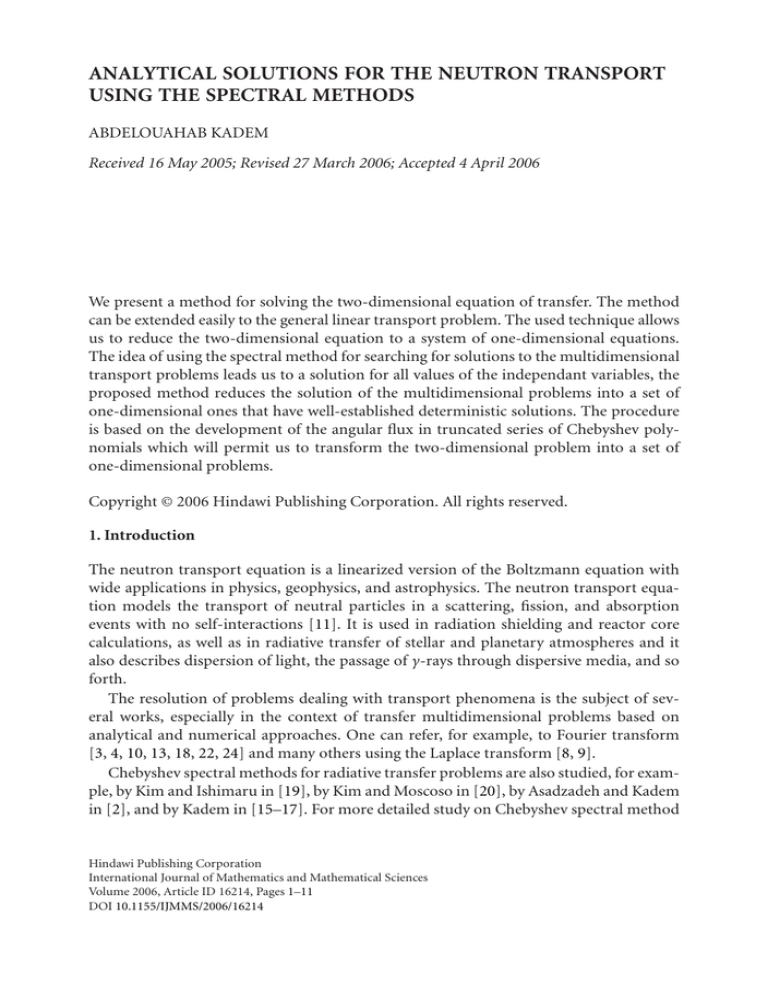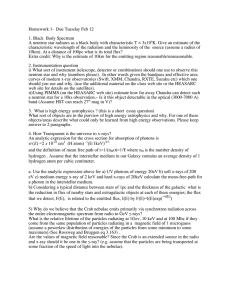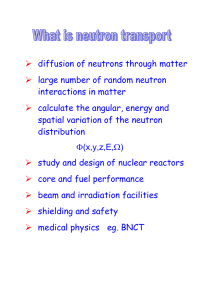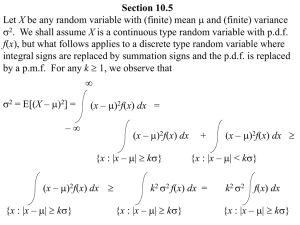
ANALYTICAL SOLUTIONS FOR THE NEUTRON TRANSPORT
USING THE SPECTRAL METHODS
ABDELOUAHAB KADEM
Received 16 May 2005; Revised 27 March 2006; Accepted 4 April 2006
We present a method for solving the two-dimensional equation of transfer. The method
can be extended easily to the general linear transport problem. The used technique allows
us to reduce the two-dimensional equation to a system of one-dimensional equations.
The idea of using the spectral method for searching for solutions to the multidimensional
transport problems leads us to a solution for all values of the independant variables, the
proposed method reduces the solution of the multidimensional problems into a set of
one-dimensional ones that have well-established deterministic solutions. The procedure
is based on the development of the angular flux in truncated series of Chebyshev polynomials which will permit us to transform the two-dimensional problem into a set of
one-dimensional problems.
Copyright © 2006 Hindawi Publishing Corporation. All rights reserved.
1. Introduction
The neutron transport equation is a linearized version of the Boltzmann equation with
wide applications in physics, geophysics, and astrophysics. The neutron transport equation models the transport of neutral particles in a scattering, fission, and absorption
events with no self-interactions [11]. It is used in radiation shielding and reactor core
calculations, as well as in radiative transfer of stellar and planetary atmospheres and it
also describes dispersion of light, the passage of γ-rays through dispersive media, and so
forth.
The resolution of problems dealing with transport phenomena is the subject of several works, especially in the context of transfer multidimensional problems based on
analytical and numerical approaches. One can refer, for example, to Fourier transform
[3, 4, 10, 13, 18, 22, 24] and many others using the Laplace transform [8, 9].
Chebyshev spectral methods for radiative transfer problems are also studied, for example, by Kim and Ishimaru in [19], by Kim and Moscoso in [20], by Asadzadeh and Kadem
in [2], and by Kadem in [15–17]. For more detailed study on Chebyshev spectral method
Hindawi Publishing Corporation
International Journal of Mathematics and Mathematical Sciences
Volume 2006, Article ID 16214, Pages 1–11
DOI 10.1155/IJMMS/2006/16214
2
Analytical solutions for the neutron transport
and also approximations by the spectral methods, we refer the reader to monographs by
Boyd [6] and Bernardi and Maday [5].
The neutron transport problem was studied analytically by, for example, [12, 23]. The
stationary monoenergetic transport of neutrons in a domain Ω surrounded by vacuum
can be represented by the following integrodifferential equation. Given a source S and the
coefficients α and σ, find the angular flux f such that for μ ∈ S2 ,
μ · ∇u(x,u) +
S2
σ(x,μ,η)u(x,η)dη + S(x,μ),
for x ∈ Ω,
(1.1)
for x ∈ Γ− = x ∈ Γ = ∂Ω : μ · n(x) < 0 ,
u(x,μ) = 0,
where σ is the transfer kernel (collision function), α is the total cross-section, S2 = {μ ∈
R3 : |μ| = 1}, n(x) is the outward unit normal to Γ at x ∈ Γ, and μ · ∇ = 3i=1 μi (∂/∂xi ),
i = 1,2,3.
There also exist analogues of (1.1) in different geometries. We have, for example, the
following case.
Slab geometry x ∈ (0,a), μ ∈ (−1,1), a > 0,
μ
∂u
(x,μ) + α(x,μ)u(x,μ) =
∂x
u(x,μ) = 0,
1
−1
σ(x,μ,η)u(x,η)dη + S(x,μ),
u(a,μ) = 0,
for μ > 0,
(1.2)
for μ < 0.
Two-dimensional geometry: x ∈ Ω ⊂ R2 , μ ∈ S = (μ ⊂ R2 : |μ| = 1),
μ · ∇u(x,μ) + α(x,μ)u(x,μ) =
S
σ(x,μ,η)u(x,η)dη + S(x,μ),
(1.3)
for x ∈ Γ−μ .
u(x,μ) = 0,
Cylindrical domain with functions being constant in the x3 -direction:
x ∈ CR = Ω × R,
μ · ∇u(x,μ) + α(x)u(x,μ) =
Ω ⊂ R2 , μ ∈ D = μ ∈ R2 : |μ| ≤ 1 ,
D
u(x,η) 1 − |η|2
u(x,μ) = 0,
−1/2
σ(x,μ,η)dη + S(x,μ),
(1.4)
for x ∈ Γ−μ .
A variety of numerical methods for the neutron transport equation have been proposed in the literature. In general, these methods are based on using quadrature formulas for the discretization of the angular variable (discrete-ordinates method), any other
classical method, such as the doubling method can be used, and finite element or finite
difference methods for the discretization of the spatial variable. Most of the previous theoretical convergence analysis of such numerical methods is concerned with the slab case
(1.2).
In this paper, based on analytical procedures, we use the spectral method [14] to decompose the two-dimensional problem into a set of one-dimensional problems that can
Abdelouahab Kadem 3
be solved by many methods, among others, we mention the discrete-ordinates method
[11, 21]. The method is based on the expansion of the flux in a truncated series of Chebyshev polynomials [1].
Truncating and replacing this expansion into the transport equation, it is then expected that the coefficients of the expansion must satisfy one-dimensional transport equations, the convergence is then studied.
2. The two-dimensional spectral solution
Consider the following problem:
T f (r,Ψ) = K f (r,Ψ) + S(r,Ψ),
(r,Ψ) ∈ Q = R × D,
(2.1)
f (r,Ψ) = 0 for (r,Ψ) ∈ Γ− ,
def
where R =]0,a]×]0,b], D = {Ψ ∈ R2 , Ψ2 < 1}, Γ− = {(r,Ψ) ∈ ∂R × D, Ψ · n(r) < 0},
and n(r) designates the normal outside vector at ∂R in r. We suppose furthermore that
for x = 0, f (0, y, −μ,η) = g1 (y;μ,η); and for y = 0, f (x,0, −μ,η) = g2 (x;μ,η). Here the
flux are specified.
functions g1 (y,μ,η) and g2 (x,μ,η) describing some incidental
−
The operator of collision K is defined by K f (r,Ψ) = ϑs (Ψ,Ψ ) f (r,Ψ )dΨ , where ϑs
D
is a positive bounded kernel.
The operator of transport T is defined by T f (r,Ψ) = Ψ · ∇ f (r,Ψ) + σ f (r,Ψ) with
def
D(T) = { f ∈ L p (Q), Ψ · ∇ f ∈ L p (Q), f (r,Ψ) = 0 on Γ− , 1 < p < +∞}. S denotes a positive term source, σ denotes the total effective section supposed to be constant, and f
represents the flux of neutrons to be determined.
In the considered geometry, one has Ψ · ∇ f (r,Ψ) = μ(∂ f /∂x) + η(∂ f /∂y), r = (x, y),
and Ψ = (μ,η), (2.1) spells then
μ
∂
∂
f (x, y,μ,η) + η f (x, y,μ,η) + σ f (x, y,μ,η)
∂x
∂y
=
1
−1
(2.2)
ϑs μ,η;μ ,η f x, y;μ ,η dμ dη + S(r,Ψ)
for 0 < x ≤ a, and −1 < y ≤ 1. Here f (x, y,μ,η) is the flux of neutrons in the direction
defined by μ ∈ [−1,1] and η ∈ [−1,1]; μ and η, respectively, denote the cosine and the
sine of the polar angle.
We seek a solution of (2.2) subject to the boundary conditions of the form
f (0, y; −μ,η) = g1 (y;μ,η),
f (a, y; −μ,η) = 0
(2.3)
for 0 < μ ≤ 1, −1 ≤ η ≤ 1, and
f (x,0;μ, −η) = g2 (x;μ,η),
f (x,b;μ,η) = 0
for −1 < μ < 1, −1 < η ≤ 1, and 0 < b < 1.
(2.4)
4
Analytical solutions for the neutron transport
We first expand the flux f (x, y;μ,η) via a truncated series of Chebyshev polynomials
in the y variable:
f (x, y;μ,η) =
I
fi (x,μ,η)Ti (y).
(2.5)
i =0
We then determine the components fi (x,μ,η), for i = 1,...,I, to define the flux given
by (2.5).
For the first component f0 (x,μ,η), we substitute (2.5) into the boundary conditions at
y = 0 and y = b, given by (2.4), to find
f0 (x,μ,η) = g2 (x,μ,η) −
I
Ti (0)
i=1
f0 (x,μ,η) = −
I
Ti (b)
i =1
T0 (b)
T0 (0)
fi (x,μ,η),
−1 < μ < 1, −1 < η < 1,
(2.6)
−1 < μ < 1, −1 < η < 1, 0 < b < 1,
fi (x,μ,η),
where 0 < x ≤ a, −1 ≤ μ ≤ 1, and assuming that Ti (0) and Ti (b) are different from
zero.
We now substitute (2.5) into (2.2), multiply the resulting equation by Tk (y)/ 1 − y 2 ,
and integrate in the y variable in the interval (−1,1) with k = 1,...,I, to get the following
one-dimensional transport problems:
μ
∂
fk (x,μ,η) + σ fk (x,μ,η) =
∂x
1
−1
ϑs (μ,η;μ ,η ) fk (x;μ ,η )dμ dη + Gk (x;μ,η),
(2.7)
with
Gk (x;μ,η) = Sk (x,μ,η) − η
I
Aki fk (x,μ,η),
(2.8)
i=k+1
where
Aki
2 − δk,0
=
π
1
d Ti (y)
Tk (y)d y,
d
−1 y 1 − y 2
2 − δk,0
Sk (x,μ,η) =
π
(2.9)
1
Tk (y)
S(x, y,μ,η) d y,
−1
1 − y2
(2.10)
and where δk,0 denotes the Kronecker delta.
The components fk (x;μ,η) satisfy the following boundary conditions at x = 0, and at
x = a:
2 − δk,0
fk (0, −μ,η) =
π
1
Tk (y)
g1 (y;μ,η) d y,
−1
1 − y2
fk (a, −μ,η) = 0,
for 0 < μ ≤ 1 and 0 ≤ η ≤ 1.
(2.11)
Abdelouahab Kadem 5
In addition, by taking into account the summation term in (2.8), one can see that
one can resolve the one-dimensional transfer problem given by (2.7)–(2.10) to define the
components fk (x,μ,φ) for k = I,... ,1, in this decreasing order to avoid the coupling of
the equations; once this is done, the flux of neutrons is completely determined by (2.5).
3. Specific application of the method
Consider the three-dimensional neutron transport equation written as
μ
∂
∂
∂
Ψ(x,μ,θ) + 1 − μ2 cosθ Ψ(x,μ,θ) + sinθ Ψ(x,μ,θ) + σt Ψ(x,μ,θ)
∂x
∂y
∂z
=
1 2π
−1
0
(3.1)
σs μ ,θ −→ μ,θ Ψ x,μ ,θ dθ dμ + S(x,μ,θ),
where we assume that the spatial variable x :=(x, y,z) varies in the cubic domain Ω :=
{(x, y,z) : −1 ≤ x, y,z ≤ 1}, and Ψ(x, μ,θ) := Ψ(x, y,z,μ,θ) is the angular flux in the direction defined by μ ∈ [−1,1] and θ ∈ [0,2π].
We seek for a solution of (3.1) satisfying the following boundary conditions.
For the boundary terms in x, for 0 ≤ θ ≤ 2π,
⎧
⎪
⎨ f1 (y,z,μ,θ),
Ψ(x = ±1, y,z,μ,θ) = ⎪
⎩0,
x = −1, 0 < μ ≤ 1,
x = 1, −1 ≤ μ < 0.
(3.2)
For the boundary terms in y and for −1 ≤ μ < 1,
⎧
⎪
⎨ f2 (x,z,μ,θ),
Ψ(x, y = ±1,z,μ,θ) = ⎪
⎩0,
y = −1, 0 < cosθ ≤ 1,
y = 1, −1 ≤ cosθ < 0.
(3.3)
Finally, for the boundary terms in z, for −1 ≤ μ < 1,
⎧
⎪
⎨ f3 (x, y,μ,θ),
Ψ(x, y,z = ±1,μ,θ) = ⎪
⎩0,
z = −1, 0 ≤ θ < π,
z = 1, π < θ ≤ 2π.
(3.4)
Here we assume that f1 (y,z,μ,φ), f2 (x,z,μ,φ), and f3 (x, y,μ,φ) are given functions.
Expanding the angular flux Ψ(x, y,z,μ,φ) in a truncated series of Chebyshev polynomials Ti (y) and R j (z) leads to
Ψ(x, y,z,μ,θ) =
J
I i=0 j =0
Ψi, j (x,μ,θ)Ti (y)R j (z).
(3.5)
6
Analytical solutions for the neutron transport
Inserting (3.5) into (3.1), multiplying the resulting expressions by (Ti (y)/ 1 − y 2 ) ×
√
(R j (z)/ 1 − z2 ), and integrating over y and z, we obtain I × J one-dimensional transport problems, namely,
μ
∂Ψα,β
(x,μ,φ) + σt Ψα,β (x,μ,φ)
∂x
=
1
−1
(3.6)
σs μ ,φ −→ μ,φ Ψα,β x,μ ,φ dφ dμ + Gα,β (x;μ,φ),
where
Gα,β (x;μ,η) = Sα,β (x,μ,φ) − 1 − μ2
I
× cosφ
Aαi Ψα, j (x,μ,φ) + sinφ
α=i+1
J
β
B j Ψi,β (x,μ,φ)
(3.7)
,
β= j+1
with
Sα,β (x,μ,φ) =
2 − δα,0 2 − δβ,0
π2
1
2 − δα,0
π
Aαi =
β
Bj =
Tα (μ)
−1
2 − δβ,0
π
1 − μ2
Tα (y)Tβ (z)
dμ S(x, y,z,μ,φ)dz d y,
1 − y 2 1 − z2
1
Ti (y)
d Tα (y) d y,
−1 d y
1 − y2
1
T j (z)
d
Tβ (z) √
dz.
1 − z2
−1 dz
(3.8)
The corresponding discrete-ordinates equation [11] is then
μm
∂Ψα,β x,μm ,φm + σt Ψα,β x,μm ,φm
∂x
=
M
ωn Ψα,β x,μm ,φm + Gα,β x;μm ,φm
(3.9)
n =1
and we also expand Ψα,β (x,μm ,φm ) in a truncated series of Chebyshev polynomials, that is,
Ψα,β x,μm ,φm
M
Ck x,φm Tk μm
=
1 − μ2m
k =0
(3.10)
Abdelouahab Kadem 7
bringing (3.10) in (3.9) to get
M
∂ Ck x,φm Tk μm
μm
∂x k=0
1 − μ2m
=
M
ωn
n =1
+ σt
M
Ck x,φm Tk μm
1 − μ2m
k =0
M
Ck x,φm Tk μm
+ Gα,β x;μm ,ηm
2
1 − μm
k =0
(3.11)
with
Gα,β x;μm ,ηm
= Sα,β (x,μ,φ) − 1 − μ2
× cosφ
I
Aαi
α=i+1
J
M
M
Ck x,φm Tk μm
β Ck x,φm Tk μm
+ sinφ
Bj
.
1 − μ2m
1 − μ2m
k =0
β= j+1
k =0
(3.12)
Multiplying (3.11) by Tl (μm ) and integrating over μm ∈ [−1,1], we find
∂ Ck x,φm
∂x k=0
M
μm
=
M
ωn
n =0
M
1
M
1 Tk μm Tl μm
dμm + σt Ck x,φm
dμm
−1
1 − μ2m
1 − μ2m
k =0
Tk μm Tl μm
−1
Ck x,φm
1
k =0
1
dμm +
Gα,β x;μm ,ηm Tl μm dμm
2
−
1
1 − μm
Tk μm Tl μm
−1
(3.13)
with
1
−1
Gα,β x;μm ,ηm Tl μm dμm
=
1
−1
×
M
M
k =0
I
Aαi
i=α+1
Ck x,φm
Ck x,φm
1
−1
k =0
×
Sα,β x,μm ,φm Tl μm dμm − cosφm 1 − μ2m
1
−1
J
β
dμm + sinφm 1 − μ2m
Bj
2
1 − μm
j =β+1
Tk μm Tl μm
dμm ,
1 − μ2m
Tk μm Tl μm
(3.14)
8
Analytical solutions for the neutron transport
where
2 − δα,0
π
Aαi =
1
Ti (y)
d Tα (y) Tl μm d y dμm ,
−1 d y
1 − y2
2 − δβ,0
β
Bj =
π
(3.15)
1
T j (z)
d
Tβ (z) √
Tl μm dz dμm
2
1−z
−1 dz
by using the properties of Chebyshev polynomials to (3.14) to get
1
−1
Gα,β x;μm ,ηm Tl μm dμm
=
1
−1
Sα,β x,μm ,φm Tl μm
I
×
i=α+1
(3.16)
J
Aαi cosφm +
π dμm −
1 − μ2m Ck x,φm
2 − δm,0
β
B j sinφm ,
j =β+1
then (3.9) becomes
∂C
1 − μ2m
μm m + σt −
∂x
m=0
=
M
π
2 − δm,0
1
I
i=α+1
−1
Aαi cosφm −
J
β
B j sinφm
Cm
j =β+1
(3.17)
Sα,β x,μm ,φm Tl μm dμm .
After written in vector and matrix notation and regrouping the coefficients Cm together
in (3.11), we can derive the following differential equation:
∂Cm
+ DCm = Em ,
∂x
(3.18)
where Dm = (1/μm )Bm and Em = (1/μm )Am with
Am :=
Bm := σt −
π
2 − δm,0
M m=0
1
1 − μ2m
−1
Sα,β x,μm ,φm Tl μm dμm ,
I
Aαi cosφm −
i=α+1
J
β
B j sinφm
(3.19)
,
j =β+1
the solution of differential equation for the vector Cm is thus constructed as follows:
Cm (x) = e−Dx Cm (0) −
x
0
e−(x−ξ)D Em (ξ)dξ;
(3.20)
(3.20) depends on vector Cm (0). Having established an analytical formulation for the exponential appearing in (3.20), the unknown components of vector Cm (0) for the boundary problem (3.1) can be readily obtained applying the boundary conditions (3.2), (3.3),
and (3.4).
Abdelouahab Kadem 9
To derive an analytical formulation for the exponential of matrix D, appearing in
(3.20), we use the Sumudu transform method [15].
4. Study of the spectral approximation
Now we expand
(N)
Ψα,β,N x,φm =
m=0
(N)
Cm
cos mφm ,
(4.1)
(N)
is the approximation to the coefficient Cm by the consideration of the trunwhere Cm
cated series Ψα,β,N .
From spectral analysis, we know that when a function is infinitely smooth and all its
derivatives exist, then the coefficients appearing in its sine or cosine series go to zero faster
than 1/n. Moreover, if the function and all its derivatives are periodic, then the decay is
faster than any power of 1/n.
However, as indicated by Canuto et al. [7], in practice this decay cannot be observed
before enough coefficients that represent the essential structures of the function are considered.
In the calculation, one can test the convergence of the cosine truncated series defined
in (4.1) by evaluating
sup
ΨN+1 (k) − ΨN (k)
ΨN (k)
k
≤ ,
(4.2)
where is the required precision. In general, the few first coefficients of the series are
enough to generate the angular flux.
If N is the chosen value, we can write
(N)
= 0 ∀n > N.
Cm
(4.3)
Combining therefore (4.3) and (3.20), we will now describe the necessary algorithm to
(N)
obtain all the cosine coefficients Cm
.
Step 0. N = 0; for n = N = 0,
−1
C0(0) (x) = e−A Bx C0(0) (0) −
x
0
−1
e −A
B(x−s)
A0 (x)dx,
(4.4)
with
A0 := π
1
−1
Sα,β x,μ0 ,φ0 Tl μ0 dμ0
(4.5)
which is well known, and thus C0(0) (x) is completely determined. To finish the step, we
apply (4.1) to obtain the first approximation to the angular flux, that is, Ψ0 .
10
Analytical solutions for the neutron transport
Step 1. N = 1; for n = 0,
−1
C0(1) (x) = e−A Bx C0(1) (0) −
x
0
−1
e −A
B(x−s)
A1 (x)dx,
(4.6)
with
A1 :=
π
2
1
−1
for n = 1
−1
C1(1) (x) = e−A
Bx
Sα,β x,μ1 ,φ1 Tl μ1 dμ1 ;
C1(1) (0) −
x
0
−1
e −A
B(x−s)
A1 (x)dx,
(4.7)
(4.8)
with
π
A1 :=
2
1
−1
Sα,β x,μ1 ,φ1 Tl μ1 dμ1 .
(4.9)
Bringing the approximated solution for C0(0) obtained at Step 0 inside (4.8) and iterating with (4.4), we obtain immediately the approximated coefficients C0(1) and C1(1) . To
finish the step, we evaluate through (4.1) the new approximation Ψ1 and perform the
precision condition defined in (4.2). If (4.2) is verified, the calculation is stopped; if not,
we go to Step 1 and do likewise until the convergence condition in (4.2) is fulfilled.
−1
With the above algorithm, we only need knowledge of the operator e−A Bx (the problem was solved previously by using the Sumudu transform [15]).
5. Conclusion
An adaptation of the method to study and to prove convergence of the spectral solution
in the framework of the analytical solution may be possible. Just some preliminary results
were obtained. In this context we study a quadrature approximation of weighted integrals
for a class of functions relevant to our purpose problem and derive some quadrature error
estimate. Our attention is now focused in this direction.
Acknowledgment
I wish to thank the reviewers for several useful comments.
References
[1] G. Arfken, Mathematical Methods for Physicists, 2nd ed., Academic Press, New York, 1972.
[2] M. Asadzadeh and A. Kadem, Chebyshev spectral-SN method for the neutron transport equation,
to appear in Computers and Mathematics with Applications.
[3] L. Ben Jaffel and A. Vidal-Madjar, New developments in the discrete ordinate method for the resolution of the radiative transfer equation, Astronomy and Astrophysics 220 (1989), no. 1-2, 306–312.
, A new method for the resolution of the radiative transfer equation in three-dimensional
[4]
geometry. I. Theory, The Astrophysical Journal 350 (1990), no. 2, part 1, 801–818.
[5] C. Bernardi and Y. Maday, Approximations Spectrales de Problèmes aux Limites Elliptiques, Mathematics & Applications, vol. 10, Springer, Paris, 1992.
Abdelouahab Kadem 11
[6] J. P. Boyd, Chebyshev and Fourier Spectral Methods, 2nd ed., Dover, New York, 2001.
[7] C. Canuto, M. Y. Hussaini, A. Quarteroni, and T. A. Zang, Spectral Methods in Fluid Dynamics,
Springer Series in Computational Physics, Springer, New York, 1988.
[8] A. V. Cardona and M. T. Vilhena, A solution of linear transport equation using Chebyshev polynomials and Laplace transform, Kerntechnik 59 (1994), no. 6, 278.
, A solution of the linear transport equation using Walsh function and Laplace transform,
[9]
Annals of Nuclear Energy 21 (1994), no. 8, 495–505.
[10] K. M. Case and R. D. Hazeltine, Three-dimensional linear transport theory, Journal of Mathematical Physics 11 (1970), no. 4, 1126–1135.
[11] S. Chandrasekhar, Radiative Transfer, Oxford University Press, London, 1960.
[12] B. Davison and J. B. Sykes, Neutron Transport Theory, The Clarendon Press, Oxford University
Press, London, 1957.
[13] L. Debnath, Integral Transforms and Their Applications, CRC Press, Florida, 1995.
[14] D. Gottlieb and S. A. Orszag, Numerical Analysis of Spectral Methods: Theory and Applications,
SIAM, Pennsylvania, 1977.
[15] A. Kadem, Solving the one-dimensional neutron transport equation using Chebyshev polynomials
and the Sumudu transform, Analele Universitatii din Oradea. Fascicola Matematica 12 (2005),
153.
, New developments in the discrete ordinates approximation for three dimensional transport
[16]
equation, to appear in Analele Universitatii din Oradea. Fascicola Matematica.
, Solution of the Three-Dimensional Transport Equation Using the Spectral Methods, sub[17]
mitted.
[18] H. G. Kaper, Elementary solutions of the reduced three-dimensional transport equation, Journal of
Mathematical Physics 10 (1969), no. 2, 286–297.
[19] A. D. Kim and A. Ishimaru, A Chebyshev spectral method for radiative transfer equations applied
to electromagnetic wave propagation and scattering in a discrete random medium, Journal of Computational Physics 152 (1999), no. 1, 264–280.
[20] A. D. Kim and M. Moscoso, Chebyshev spectral methods for radiative transfer, SIAM Journal on
Scientific Computing 23 (2002), no. 6, 2074–2094.
[21] E. E. Lewis and W. F. Miller Jr., Computational Methods of Neutron Transport, John Wiley & Sons,
New York, 1984.
[22] C. E. Siewert and W. L. Dunn, The searchlight problem in radiative transfer, Journal of Quantitative Spectroscopy and Radiative Transfer 41 (1989), no. 6, 467–481.
[23] V. S. Vladimirov, Mathematical problems in the one-velocity theory of particle transport, Trudy
Matematicheskogo Instituta Imeni V. A. Steklova 61 (1961), English translation: Atomic Energy
of Canada Limited, AECL. 1661, Chalk River, Ontario (1963).
[24] M. M. R. Williams, Approximate solutions of the neutron transport equation in two and three
dimension systems, Nuklconik 9 (1967), 305.
Abdelouahab Kadem: Department of Mathematics, Faculty of Sciences, University of Sétif,
Sétif 19000, Algeria
E-mail address: abdelouahabk@yahoo.fr





